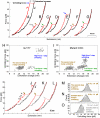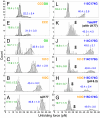Triplex structures in an RNA pseudoknot enhance mechanical stability and increase efficiency of -1 ribosomal frameshifting
- PMID: 19628688
- PMCID: PMC2722267
- DOI: 10.1073/pnas.0905046106
Triplex structures in an RNA pseudoknot enhance mechanical stability and increase efficiency of -1 ribosomal frameshifting
Abstract
Many viruses use programmed -1 ribosomal frameshifting to express defined ratios of structural and enzymatic proteins. Pseudoknot structures in messenger RNAs stimulate frameshifting in upstream slippery sequences. The detailed molecular determinants of pseudoknot mechanical stability and frameshifting efficiency are not well understood. Here we use single-molecule unfolding studies by optical tweezers, and frameshifting assays to elucidate how mechanical stability of a pseudoknot and its frameshifting efficiency are regulated by tertiary stem-loop interactions. Mechanical unfolding of a model pseudoknot and mutants designed to dissect specific interactions reveals that mechanical stability depends strongly on triplex structures formed by stem-loop interactions. Combining single-molecule and mutational studies facilitates the identification of pseudoknot folding intermediates. Average unfolding forces of the pseudoknot and mutants ranging from 50 to 22 picoNewtons correlated with frameshifting efficiencies ranging from 53% to 0%. Formation of major-groove and minor-groove triplex structures enhances pseudoknot stem stability and torsional resistance, and may thereby stimulate frameshifting. Better understanding of the molecular determinants of frameshifting efficiency may facilitate the development of anti-virus therapeutics targeting frameshifting.
Conflict of interest statement
The authors declare no conflict of interest.
Figures





Similar articles
-
Programmed -1 frameshifting efficiency correlates with RNA pseudoknot conformational plasticity, not resistance to mechanical unfolding.Proc Natl Acad Sci U S A. 2012 Oct 2;109(40):16167-72. doi: 10.1073/pnas.1204114109. Epub 2012 Sep 17. Proc Natl Acad Sci U S A. 2012. PMID: 22988073 Free PMC article.
-
Mechanical unfolding kinetics of the SRV-1 gag-pro mRNA pseudoknot: possible implications for -1 ribosomal frameshifting stimulation.Sci Rep. 2016 Dec 21;6:39549. doi: 10.1038/srep39549. Sci Rep. 2016. PMID: 28000744 Free PMC article.
-
An intermolecular RNA triplex provides insight into structural determinants for the pseudoknot stimulator of -1 ribosomal frameshifting.Nucleic Acids Res. 2010 Mar;38(5):1676-85. doi: 10.1093/nar/gkp1107. Epub 2009 Dec 8. Nucleic Acids Res. 2010. PMID: 20007152 Free PMC article.
-
Structure, stability and function of RNA pseudoknots involved in stimulating ribosomal frameshifting.J Mol Biol. 2000 Apr 28;298(2):167-85. doi: 10.1006/jmbi.2000.3668. J Mol Biol. 2000. PMID: 10764589 Free PMC article. Review.
-
Revealing -1 programmed ribosomal frameshifting mechanisms by single-molecule techniques and computational methods.Comput Math Methods Med. 2012;2012:569870. doi: 10.1155/2012/569870. Epub 2012 Apr 1. Comput Math Methods Med. 2012. PMID: 22545064 Free PMC article. Review.
Cited by
-
Conformational dynamics of the frameshift stimulatory structure in HIV-1.RNA. 2017 Sep;23(9):1376-1384. doi: 10.1261/rna.061655.117. Epub 2017 May 18. RNA. 2017. PMID: 28522581 Free PMC article.
-
The translational landscape of SARS-CoV-2 and infected cells.bioRxiv [Preprint]. 2021 Oct 7:2020.11.03.367516. doi: 10.1101/2020.11.03.367516. bioRxiv. 2021. Update in: mBio. 2022 Jun 28;13(3):e0081522. doi: 10.1128/mbio.00815-22. PMID: 33173862 Free PMC article. Updated. Preprint.
-
Structural and molecular basis for Cardiovirus 2A protein as a viral gene expression switch.Nat Commun. 2021 Dec 9;12(1):7166. doi: 10.1038/s41467-021-27400-7. Nat Commun. 2021. PMID: 34887415 Free PMC article.
-
Structure-altering mutations of the SARS-CoV-2 frameshifting RNA element.Biophys J. 2021 Mar 16;120(6):1040-1053. doi: 10.1016/j.bpj.2020.10.012. Epub 2020 Oct 21. Biophys J. 2021. PMID: 33096082 Free PMC article.
-
Shapify: Paths to SARS-CoV-2 frameshifting pseudoknot.PLoS Comput Biol. 2023 Feb 28;19(2):e1010922. doi: 10.1371/journal.pcbi.1010922. eCollection 2023 Feb. PLoS Comput Biol. 2023. PMID: 36854032 Free PMC article.
References
Publication types
MeSH terms
Substances
Grants and funding
LinkOut - more resources
Full Text Sources
Other Literature Sources

